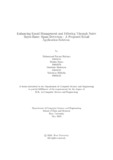| dc.contributor.advisor | Rhaman , Md. Khaliliur | |
| dc.contributor.author | Rahman, Muhammad Farhan | |
| dc.contributor.author | Enam, Maisha | |
| dc.contributor.author | Shahreyar, Shadman | |
| dc.contributor.author | Mithylin, Valentina | |
| dc.date.accessioned | 2023-12-05T08:38:20Z | |
| dc.date.available | 2023-12-05T08:38:20Z | |
| dc.date.copyright | 2023 | |
| dc.date.issued | 2023-05 | |
| dc.identifier.other | ID 19101514 | |
| dc.identifier.other | ID 19101179 | |
| dc.identifier.other | ID 19101510 | |
| dc.identifier.other | ID 19101242 | |
| dc.identifier.uri | http://hdl.handle.net/10361/21921 | |
| dc.description | This thesis is submitted in partial fulfillment of the requirements for the degree of Bachelor of Science in Computer Science, 2023. | en_US |
| dc.description | Cataloged from PDF version of thesis. | |
| dc.description | Includes bibliographical references (pages 59-60). | |
| dc.description.abstract | Spam emails make up almost half of the global mail traffic. These emails take up
a large amount of space in the user’s inbox. However, a lot of time malware and
viruses are embedded in these emails in the form of attachments or phishing links
provided within the disguised emails. Moreover, sometimes important emails are
flagged as spam and they are sent to spam folders causing that email to go completely unnoticed. Sometimes, even emails from educational institutions may follow
a similar fate. Our goal is to build a machine learning-based email management
system that not only effectively sorts and organizes emails into user-preferred categories but also contains an improved spam email detection system to ensure that
important ones do not find their way into the spam folders in our inboxes. Our
proposed model detects and blocks spam emails by understanding their context of
it. E-mails containing newsletters, advertisements, and updates can be enhanced
by adding a feature that enables machine learning to filter the email based on individual user preferences. Unwanted ones will be detected and blocked from entering
the user’s inbox, consequently saving space. We plan to build our proposed system
using the Naive Bayes algorithm which is a computational technique employed to
assess the significance of an email concerning our needs. It is a probabilistic algorithm grounded in the principles of Bayes Theorem, specifically developed to filter
out spam emails for enhanced classification of the emails. An important benefit of
this method for spam filtering is its adaptability to individual users, as we get more
and more feedback from users it can improve its prediction. This study explores
the identification of spam and non-spam emails through the utilization of the Naive
Bayes algorithm. Thus, Our system learns more about the preferences of the user
as time passes and can optimize its functionality accordingly. We also aim to build
a web application that will make the whole process of identifying and separating
emails smoother for the user. | en_US |
| dc.description.statementofresponsibility | Muhammad Farhan Rahman | |
| dc.description.statementofresponsibility | Maisha Enam | |
| dc.description.statementofresponsibility | Shadman Shahreyar | |
| dc.description.statementofresponsibility | Valentina Mithylin | |
| dc.format.extent | 60 pages | |
| dc.language.iso | en | en_US |
| dc.publisher | Brac University | en_US |
| dc.rights | Brac University theses are protected by copyright. They may be viewed from this source for any purpose, but reproduction or distribution in any format is prohibited without written permission. | |
| dc.subject | Emails | en_US |
| dc.subject | Naive bayes | en_US |
| dc.subject | Algorithm | en_US |
| dc.subject | Particle swarm optimization | en_US |
| dc.subject | Correlation based feature selection | en_US |
| dc.subject | Privacy | en_US |
| dc.subject | Security | en_US |
| dc.subject.lcsh | Natural language processing (Computer science) | |
| dc.subject.lcsh | Computer algorithm | |
| dc.title | Enhancing email management and filtering through naive bayes based spam detection : a proposed email application solution | en_US |
| dc.type | Thesis | en_US |
| dc.contributor.department | Department of Computer Science and Engineering, Brac University | |
| dc.description.degree | B.Sc. in Computer Science and Engineering | |

